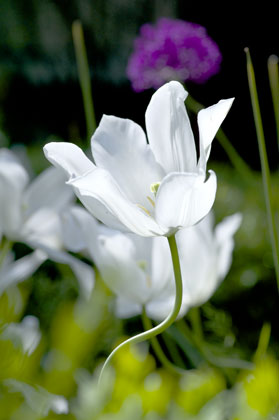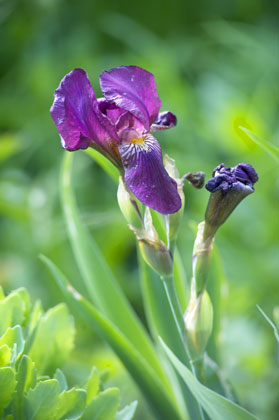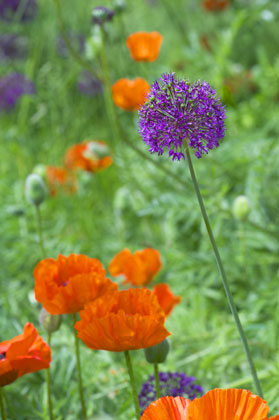Cronicle May 2012 | Chronicle July 2012
June 2012
Hello everyone! I'm just about to go into the garden. The date is 6 June 2012 and it’s early summer. Oh my goodness. Dear, beloved garden, so much has happened, so much has bloomed over (for example, the crocuses, snowdrops, daffodils and tulips), but so much is still happening. So far this year the garden has been quite spectacular, and it’s still continuing to dazzle… While the white tulips are beginning to fade, the garden is awash with a flood of alliums, which always play a prominent role in our garden at the beginning of June. So far this year I planted 700-800 bulbs, and I plan to plant an additional 600 in the autumn, and that will be it. If you’ve got space to plant, why not do so; why settle for one bulb when you can plant 100?
I've succeeded in getting down in the ground most of what I wanted to plant, but there are still some lilies that need to be planted. The sweet peas have been planted, the roses have been pruned, but there’s so much more to take care of; quite simply, looking after the garden takes a lot of time. The yellow azaleas(rhododendron luteum) by the pond are blooming beautifully, while the honeysuckle Lonicera periclymenum ’Belgica’, with its large, scented yellow-red flowers, has just come into bloom. Honeysuckles usually begin flowering at the beginning of June, but if you plant different sorts, you can enjoy honeysuckles in bloom long into August. That's worth bearing in mind – extend the summer as long as you can!
It's a warm June evening and time to take the last round in the garden for today. I can hear the gurgle of water in the pond and the fountain, and here and there toads are hopping around in the garden. With a glass of red wine in one hand and pair of scissors in the other, I'm making the usual evening round of clipping the invasive Spanish slugs (Arion vulgaris), which for the past four years have been a real problem in our garden. In Sweden, they’re popularly referred to as mördasniglar (‘murder slugs’), presumably due to the fact that they cannibalistically eat other dead slugs (not to mention the fact that they can “murder” plants!). Drinking wine, recording a tape, and cutting slugs all at the same time – that's true multi-tasking!
Going around our small orchard, I can only think “Monet, you should be here with your easel and paints.” Just now, the orchard is a veritable sea of red poppies, together with a profusion of allium ‘Purple Sensation’. What a magical combination! Last week, all the flowers and trees in the orchard gained a new neighbour in the form of a small English apple tree, St. Edmund’s Russet (my partner Reuven’s absolute favourite Apple). The tree is four years old and, hopefully, we'll get fruit already this year. Russet apples are characterised by a yellow-brown, rough skin (resembling fine sandpaper) and a somewhat nutty, sweet flavour. Reuven claims that they’re wonderful.
One is always coming cross new things to plant and do. We recently planted two new rhododendrons: one is a Catawbiense Lee’s Dark Purple, which (thanks to its masses of dark purple flowers) is a perfect match for the contemporaneously blooming alliums. The other is a delightfully sweet azalea japonica ‘Schneeperle’, which produces a froth of lovely, snow white double blooms. It will grow very slowly, reaching a height of approx. 35 cm and width of approx. 55 cm after 10 years.
But as well as bringing new things into a garden, it’s sometimes a question of taking out things, and that’s exactly what we did last week when we cut down the lilac arbour, which I regarded as a complete waste of time. Lilacs might be nice during the brief period in which they flower, but after that they’re hardly anything of beauty – just a formless mass. Lilacs might suit municipal parks, but as far as I'm concerned they’ve no place in a domestic garden (at least not in MY garden). So we've taken up all the lilacs, hopefully roots and all, and opened up quite a large area which is dotted with pretty violets. We've dismissed the idea of planting bushes there; instead, the area is going to remain open just as it is, but with mass plantings of white hyacinths for the spring.
Last weekend, we suffered an experience that made me very sad. Whilst we were away over the weekend, some person or persons (and certainly no bird!) was in our garden and stole all of the 20 or so large goldfish we had in the pond, which we have nurtured over the past eight years. Suddenly, they were simply gone. It makes me so sad – and angry. I can't help but wonder – where are you all, my beloved fish? The pond now feels so empty, and I sense the emptiness with my whole body. It's so sad.
Merely a few meters from the pond, rhododendron ‘Belle Heller’ is full of gorgeous yellow-white flowers, while complementary bunches of yellow laburnum flowers hang above. Timing is everything – and this year the timing is perfect.
This year, we've had the garden open three times for the benefit of the Red Cross, and it feels as though the cooperation has been successful and everyone has been satisfied. Hopefully, we will continue with the cooperation next year. Looking forward to further events this year, on Sunday, 22 July (12 noon to 6 pm) the garden will be open free of charge within the scope of the Land newspaper’s “Open Garden” scheme, and on Saturday the 11th and the Sunday, 12 August it will be open free of charge within the scope of the Swedish Horticultural “Thousand Gardens” scheme. On the Sunday, a wind instrument trio will be going round the garden playing music by Bellman! Why not come to one opening or the other – or both? The garden is also open for visits by societies and private parties.
Welcome!
Early summer greetings from
Stefan, A Gentleman Gardener



